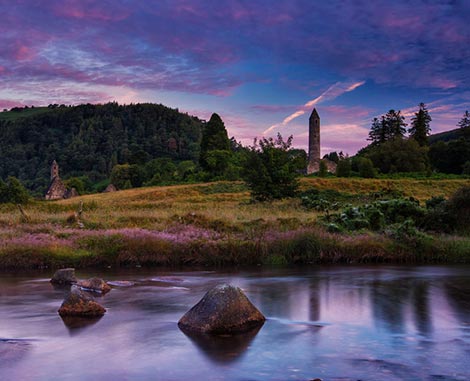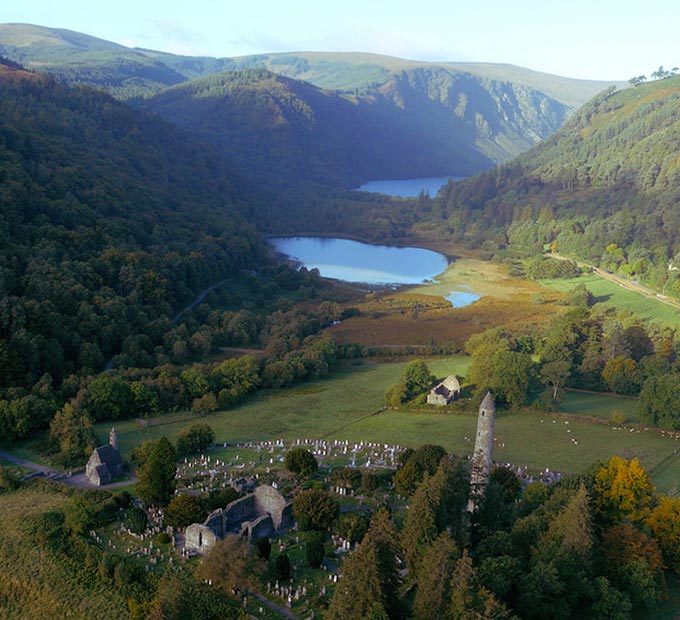Glendalough has been a place of pilgrimage since the 6th century when St. Kevin lived there as a hermit and ascetic, attracting followers and establishing a monastery there. Little is known for certain about Kevin, since the many stories we have were first written centuries after his passing. These stories and myths continue to fascinate and offer inspiration today.
St. Laurence O’Toole was abbot in the Glendalough monastery and initiated reform before being appointed Archbishop of Dublin in 1162. It is believed that he remained a monk at heart and returned to Glendalough on retreat frequently.
There is an original icon of each of these saints in St. Kevin’s Parish Church, Glendalough.
Following the tradition of pilgrimage, a series of walks has been organised to mark St Kevin’s Day on Saturday June 3rd in Glendalough. Participants will walk towards Glendalough following a choice of 7 different routes which will merge along the way with other walkers from the same area. Click here to learn more
Glendalough has attracted visitors to the shores of its two lakes for almost 1500 years. People come to experience the natural beauty of the landscape, to walk the mountains and hills and to explore the archaeological and historical monuments.
Most important of all, people come as pilgrims, responding to the sacred energy of the landscape which drew St. Kevin to withdraw here in search of his God. The spiritual heritage of Glendalough is unsurpassed. The pilgrim way has been followed for ages past by monks and holy people and even our earliest ancestors who felt the primal call to worship.
This is indeed holy ground. Pilgrim, go gently.

With its lakes nestled in a secluded valley, reflecting cascading streams and deep green fauna climbing the hills on either side, walkers, hikers and pilgrims journey from all over the world to experience the meditative quiet and natural beauty of this idyllic nature reserve and the surrounding town. Natural beauty is not the only draw for tourists though, as the site has historical and religious significance as well.
The valley for which Glendalough is named is home to the ancient site of St. Kevin’s Monastery.
The greater Glendalough area offers even more extreme visions of Ireland’s natural beauty- soaring peaks accessible by car, rivers, lakes and rocky outcroppings awarding magnificent views of the valleys below.”

Glendalough is a place of stunning natural beauty and awe-inspiring landscapes. It also offers a unique mix of natural, historical, archaeological and spiritual riches.
For thousands of years, people have been drawn to this valley carved out by glaciers during the Ice Age. The two lakes which inspired the name of Glendalough (Gleann Da Loch – valley of the two lakes) were formed when the ice thawed.

The valley is situated in Wicklow Mountains National Park which is home to forests, mountains, rivers, lakes and waterfalls. Magnificent scenery abounds. Many and varied walking trails can be found to suit all levels of agility. Wherever one looks, beautiful views meet the eye, evoking a sense of peace, tranquillity and wonder.
The valley is also a haven for wildlife and their habitats, flora and fauna. Nature conservation and ecological protection are provided by the National Parks and Wildlife Service. An Information Office in the Park offers information on local wildlife and guided walking tours e.g. Bat Walks and Dawn Chorus Walks are available.
The geological heritage of Glendalough is highlighted by the remains of two mines found in the Glendalough valley and in the adjacent valley of Glendeasan. Lead, zinc and silver are among the materials mined over a period stretching from the 1790s to 1957. A project called the Glendalough Mining Heritage Project has been established to conserve the history and heritage of mining in the area.
Glendalough National Park is also the site of a Monastic City featuring the remains of an early Irish Christian monastic settlement dating from the 6th century onwards.